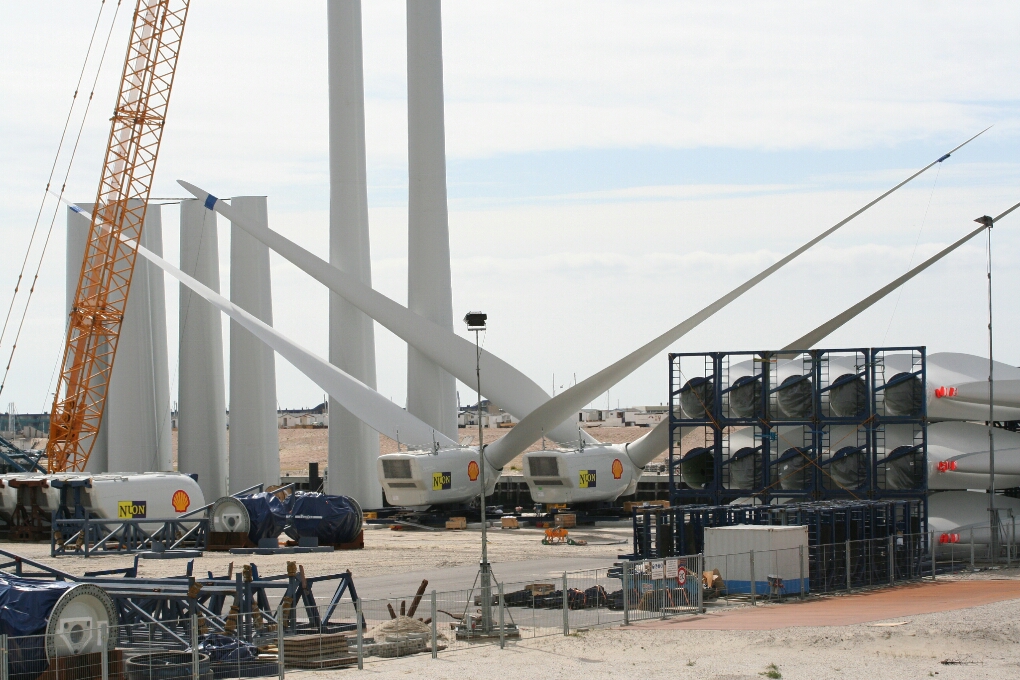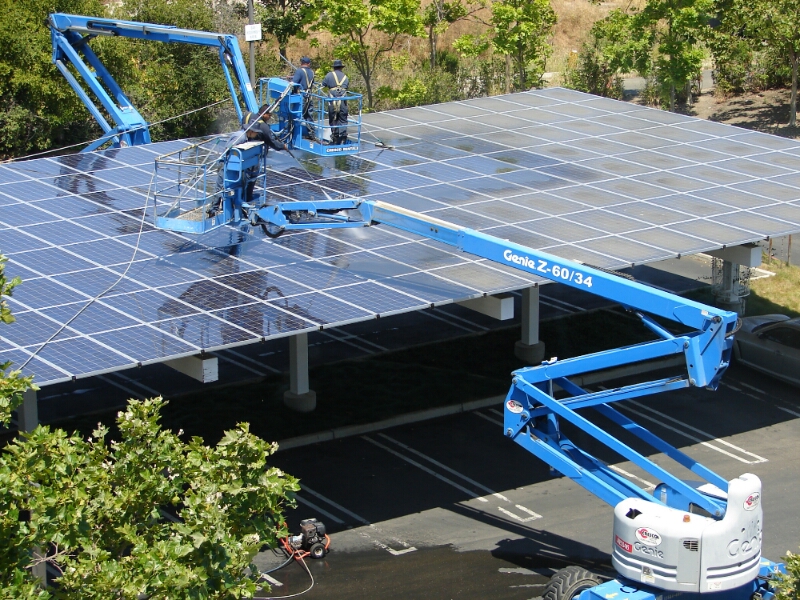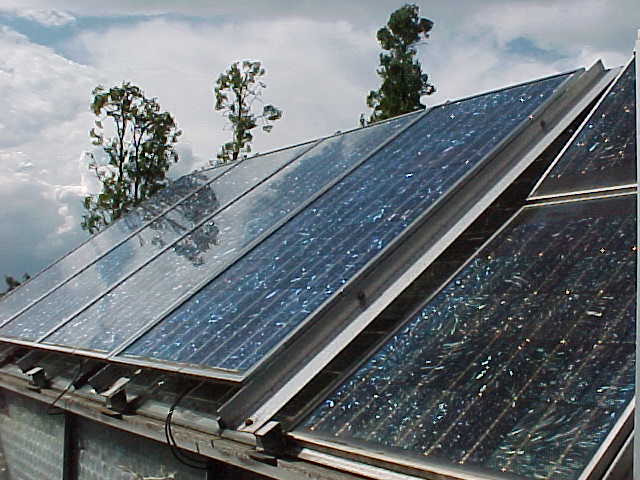A newly released report shows how the United States can cut its carbon pollution by 40 percent from 2005 levels. In the process, 2.7 million new clean energy jobs will be created, reducing the unemployment rate by 1.5 percentage points. Recently released in Nevada for the seventh annual National Clean Energy Summit, the report is titled, “Green Growth: A U.S. Program for Controlling Climate Change and Expanding Job Opportunities.”
Co-authored by the University of Massachusetts Political Economy Research Institute (PERI) and the Center for American Progress, the report quantifies the investment and technology deployment needed for the U.S. to avoid the worst consequences of climate change. The executive summary for the Green Growth report is now available online, while the complete report is scheduled for publication later this week.
This groundbreaking report quantifies the level of investment required for the United States to align emissions reductions with international goals in an economically beneficial and technically feasible manner. The specific emissions-reduction goal explored in the report is what the Intergovernmental Panel on Climate Change, has proposed for the world as a whole: reducing greenhouse gas emissions by 40 percent from 2005 levels by 2035.
To do its part to meet this goal, the United States must reduce its carbon dioxide emissions from energy-based sources by 40 percent, to 3,200 million metric tons, over roughly the next 20 years. The proposals in this report put the United States on this track to effectively mitigate global climate change.
A New Program For Controlling Climate Change And Expanding Jobs
Three areas of analysis are covered in the Green Growth report to accomplish the two primary goals of controlling climate change and expanding job opportunities:
1. It describes the need for a substantial new wave of mostly private investment in advanced energy technology and higher performing buildings, as well as significant public and private investment needed to build dramatically more efficient infrastructure.
2. It outlines how the United States can and must reduce its use of fossil fuels by 40 percent within the next 20 years, as the window of opportunity to stabilize our changing climate is small and closing rapidly.
3. The report shows that stabilizing the climate requires bold actions that the authors term the PERI-CAP scenario.
In addition to this analysis, the report outlines flexible policy options that can be utilized to take the needed actions. Notably, the report finds that this investment agenda will not only protect our climate but will also generate 2.7 million net new jobs. The breakdown of expected employment benefits are as follows:
• 4.2 million overall jobs created both by new investments and expanded levels of operations and maintenance.
• 2.7 million net increase in jobs, even afer estimated contractions in fossil fuel sectors.
• Net employment expansion at all levels of pay in the U.S. labor market and a decrease in the unemployment rate by about 1.5 percentage points—e.g., from 6.5 percent to 5 percent within the 2030 U.S. labor market.
“Climate Stabilization Is Not An Outlandish Fantasy”
Robert Pollin, lead author of the report says, “Our work shows that the fundamental imperative of climate stabilization is not an outlandish fantasy, but is truly within reach.” Co-director of PERI and distinguished professor of economics at UMass Amherst, Pollin continues, “By investing about $200 billion annually on energy efficiency and clean renewable energy for the next 20 years—meaning 1.2 percent of current U.S. gross domestic product—we can cut overall U.S. energy consumption by 30 percent relative to today, as well as expand by 400 percent the production of solar, wind and other clean renewable sources. These clean energy investments will drop U.S. CO2 emissions by 40 percent while also generating 2.7 million net new jobs. The opportunity is right before us and needs to be seized.”
The Green Growth report finds that the investment needed to stabilize our climate and improve our economy amounts to about $200 billion annually in both public and private resources. Average net public expenditures would comprise roughly one-quarter of that total, averaging $55 billion per year, which falls within the $44 billion to $60 billion per year range that the United States has devoted to clean energy investments in recent years. The report further states that if a successful carbon tax or cap were implemented as part of this plan, it would also yield public revenues averaging $200 billion per year.
To put the clean energy investment total in perspective, the following points are outlined in the executive summary report:
• Public expenditures would comprise 0.3 percent of current U.S. GDP and roughly 1.4 percent of the federal budget.
• Total expenditures—public and private—are roughly 1.2 percent of current U.S. GDP.
• A recent White House Council of Economic Advisors report found that a temperature increase of 3 degrees Celsius above pre-industrial levels would increase economic damages by $150 billion, year afer year in perpetuity.
• Total expenditures are roughly 40 percent below U.S. oil and gas industry investments for 2013.
“The Environment-Versus-Economy Is A False Dichotomy”
Heidi Garrett-Peltier, a research assistant professor at PERI, is a co-author of the Green Report. “Green Growth presents a practical program for investing in clean energy to control climate change,” Garret-Peltier states. “While much research has shown that the environment-versus-economy is a false dichotomy, this study explicitly details how private investments and public policy together can control rising emissions while creating jobs. Starting from emissions targets widely agreed upon by climate scientists, Green Growth analyzes the possibilities for energy efficiency, renewable energy, and to what extent we must continue to rely on fossil fuels, and presents a 20-year investment program that is affordable and achievable.”
According to the Executive Summary, of the $200 billion needed for annual investments, $90 billion must be invested in raising efficiency standards for the operations of buildings, transportation systems, and industrial equipment. These investments can reduce overall U.S. energy consumption by 30 percent relative to current levels. In most cases, the costs of these energy efficiency investments can be offset within an average of three years, followed by net positive financial gains.
The remaining $110 billion per year would be invested in renewable energy that generates low to zero emissions—i.e., solar, wind, geothermal, small-scale hydro, and low-emissions bioenergy—which will raise overall U.S. production from these energy sources more than fourfold. Additionally, the U.S. Energy Information Agency estimates that the average cost for producing electricity from most clean renewable sources—including wind, hydro, geothermal, and clean bioenergy—will be at rough cost parity with most nonrenewable sources by 2017.
“Saving The Planet Requires Bold, New—Yet Eminently Feasible—Policy Directions”
“The conventional wisdom is that we can either protect the environment and stop climate change or we can create jobs and grow the economy – but we can’t do both. This study shows why this is not the case,” says James Heintz, Andrew Glyn Professor of Economics and associate director of PERI, who also served as a co-author of the Green Growth report. “By investing in clean energy technologies, the U.S. economy can boost employment, become more energy-efficient and stave off the potentially devastating effects of greenhouse gas emissions. The report shows how saving the planet requires bold, new—yet eminently feasible—policy directions.”
To meet the 20-year emissions-reduction target, the Green Growth report states that the following energy and economic policies are required:
• Reductions in fossil fuel consumption by approximately 60 percent for coal, 40 percent for oil, and 30 percent for natural gas.
• Reduction of overall U.S. energy consumption by approximately 30 percent relative to current levels.
• Raising overall U.S. energy production from low to zero emissions renewables by more than fourfold.
• Reduction in oil imports to absorb most of the decline in U.S. oil consumption, which will bring a sharp decline in the U.S. trade deficit and favorable macroeconomic effects.
• Transitional support for affected communities and workers hardest hit by the reduced U.S. consumption of coal and natural gas. The federal government therefore needs to provide major transitional support for workers and communities that are facing retrenchment in order to promote economic development and job opportunity in these impacted communities and regions.
• No expansion of nuclear energy supply; despite being an emissions-free source of electricity, nuclear energy is unlikely to experience major expansion in the next two decades, due to public-safety considerations and market concerns. This report concludes that nuclear energy’s contribution to the overall U.S. energy mix will therefore remain roughly constant.
“This Is A Story Of Hope and Opportunity”
“Our research demonstrates that it is technologically and economically feasible today to create more jobs and growth, while using 40 percent less fossil fuel, improving energy efficiency 30 percent, and powering communities with four times more clean and renewable energy,” explains Bracken Hendricks, senior fellow with the Center for American Progress and a co-author of the report. “This is a story of hope and opportunity, but the window for action is small and narrowing.”
The complete Green Growth report, which is scheduled for release on Sept. 18, will be available at the Center for American Progress website. The Executive Summary is available now.
A number of comments and quotes from lawmakers, business leaders and scholars in support of the report’s findings can be found here. Pollin has also published the lead article in a Boston Review forum based on the Green Growth study. His article, “Build the Green Economy,” and discussion responses can be found on Boston Review.










